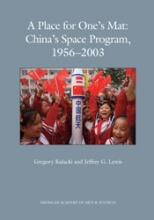A Place for One’s Mat: China’s Space Program, 1956–2003

A Place for One’s Mat: China’s Space Program, 1956–2003 is the fifth paper of the project series. Using Chinese-language sources, Gregory Kulacki and Jeffrey G. Lewis examine three formative events in the development of China’s utilization of space: the launch of the first satellite in 1970, the launch of the first communications satellite in 1984, and the first human spaceflight in 2003.
They trace the origins and basic purposes of each of these efforts and set them in the context of China’s internal history. Their central observation is that China understood each of these efforts to be a measure of national accomplishment necessary to qualify for inclusion among the major spacefaring countries that set the rules. Equity appears to have been the principal concern of China’s political leadership.
That motive is more legitimate and less belligerent than those typically attributed by foreign observers—the U.S. intelligence community in particular. The authors do not claim to provide a comprehensive account of China’s space program or an indisputable interpretation of its fundamental purposes. They do, however, provide evidence to be considered in any fair-minded assessment of the program’s global significance.